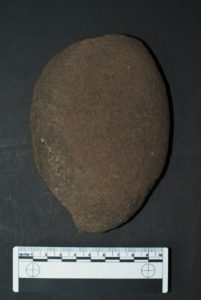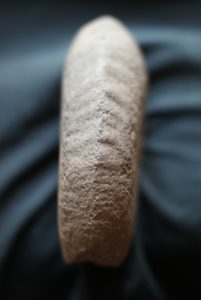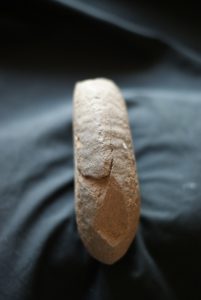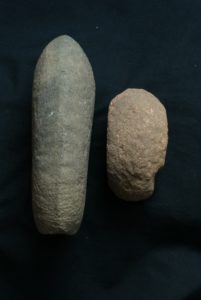Oxford Archaeology North recently excavated a Mesolithic house at Cass ny Hawin 2, Isle of Man. This house had burnt down leaving charred timbers and quantities of burnt hazelnut shell as well as the flint and stone tools lying where they were last placed before the conflagration.
The stone tools formed a fascinating collection including three unusual ground stones; bevelled pebbles and elongated hammerstones; several hammerstones or anvils as well as smoothers/rubbers; a dimpled cobble, and a grinding slab. A collection of distinctive, large, rounded cobbles was also made. These tools were used, or placed, in an organised manner within the structure and the spatial analysis of the finds is explored in the report.
The publication of the site is expected soon but for now I want to share images of one of the ground stone tools.
This fine stone tool was made from an oval cobble of medium-grained sandstone and it was shaped by pecking and grinding to form a fine bifacial bevelled edge around the perimeter of the cobble. Both faces have been ground at slight inward angles to form a splayed long-section and are slightly concave in cross-section.
The bevels are particularly defined on the long edges of the cobble where they have been very finely ground to form a curved cross-section with a sharp edge. A distinctive feature is the raised ribbed pattern worked on the surface of the ground bevels on either side. When observed side-on these ridges are angled to form chevrons with the sharp edge of the bevel as the central spine The ridges or ribs are clearly linked with how the edges were ground – and it seems likely that the edge was grooved in this pattern prior to use or further shaping. The placing of these grooves may have been to provide purchase for a substance being processed, or as decoration, or perhaps as a means of decorating another surface on which this tool was subsequently used. These ridges have then been worn to a smooth and rounded finish or in some cases are quite flattened with further working.
Just what this tool was used for can only be guessed at but the distinctive features which include a finely bevelled edge with surface preparation in the form of a clear pattern of grooves suggests that it was manufactured for a very specific purpose. On its own, this finely-shaped object could be interpreted at many levels – it may not be a tool and instead could have been shaped as a decorative or symbolic object. However, there are two other pieces of ground stone which share some characteristics such as the flat faces and bifacially bevelled edges with this object but neither have been so finely altered to shape and this would suggest a more utilitarian use for the ground stone.
There are as yet no parallels for this tool form at other sites, Mesolithic or later. The closest published comparison is the perforated and ground stone disc from Nab Head Site 2 (David and Walker 2004, Figure 17.17.4). Despite the lack of a perforation on the Cass ny Hawin 2 example as well as a different outline in plan there is close similarity in the profile of the bifacially ground angled edge around the perimeter of both pieces. This is not to say that that these artefacts were made to be used in the same way – this is highly unlikely. However, it is perhaps evidence that the template for a regular bifacially ground edge existed and across regions and time though whether it was a functional or stylistic device cannot be determined yet. Of note is the decorative grooving forming raised chevrons around the spine of the bevelled edges of the Ronaldsway object which does not occur on the disc from Nab Head.



